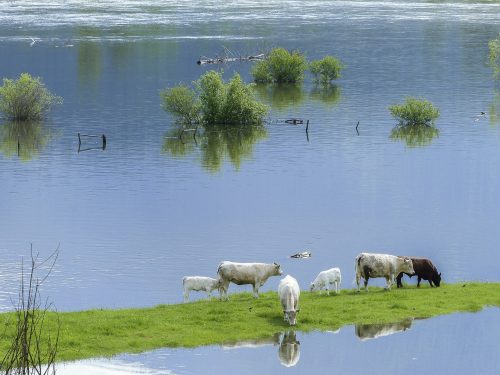Stephanie Kerr of Argyll Environmental discuss flood risk and flood planning, as well as looking in detail at flood risk on farm land
While looking at flood risk and planning, the team at Argyll Environmental Ltd interviewed Susan Harmer from Offham Farm, near Lewes, who experienced severe flooding in 2000. Susan talks about the impact the flood had on their business and urges landowners, and those considering purchasing land, to fully understand the risk flooding may pose in order to be fully prepared.
Floods can have devastating impacts on all walks of life; whether residential homes, commercial buildings through to businesses. For farms, it has the potential to affect livestock, buildings and homes.
The year 2000 saw the wettest autumn on record across the UK, with, 10,000 homes and businesses flooded across 700 locations (Met Office, 2001). In most cases, farmers found themselves completely at the mercy of the elements. In England alone over 1.3 million hectares of farmland are within flood plains, including more than half of the most productive land (Environment Agency, 2008). However, there are some precautions you can take to reduce the risk of flooding and minimise the damage caused if a flood does happen.
Planning for Flooding on the Farm
A good starting point is a Flood Warning and Evacuation Plan (FWEP). It is important that everyone on the farm, both staff and family, understand what this comprises of, so it is a good idea to have a written plan and store it somewhere readily accessible to all.
The plan should look at the following areas:
- Identify higher ground that livestock can be moved to
- List stock and machinery that can be moved away quickly from the farm to prevent loss or damage
- Identify any chemicals or fuels that could cause contamination in flood waters and consider permanently raising them above predicted flood levels
- Consult your staff with the plans, so they are aware of them and know how they can help if disaster strikes
- Design a business continuity plan to ensure business can continue as normal should flooding occur
- If you are prone to flooding, consider bulk buying and stocking materials such as sand bags, and keep them in an easily accessible area
Following this advice could not only prevent unnecessary damage to the farm and the land, but also save the lives of livestock and the damage of valuable farm machinery.
Reducing the likelihood of flooding
Managing a flood is one thing, but mitigating against one is another. Here are some ideas to consider to become more resilient, and ultimately reduce the risk of flooding on a farm:
- Consider having a Surface Water Management Plan (SWMP) carried out, particularly for the farm yard area. This will enable you to establish where best to direct run off, the likelihood of flooding, and if any precautionary measures can be put in place, such as run off ponds or sediment traps, to reduce flood risk.
- Remove stock when soils are wet in high risk pastures to avoid having to do it at the last minute, as well as to reduce the chance of compaction and poaching.
- Similarly, after harvest season, loosen soils to leave a rough surface to reduce soil compaction and allow more water to soak in rather than run off.
- Finally, any way in which water can be reused on the farm should be considered. For example, discharge any roof water into tanks or swales (rainwater harvesting) which can then be given to livestock or stored for future irrigation. In these ways you can ultimately reduce run off and allow the water table to recharge, avoiding groundwater flooding too.
Farm Developments, Conversions and Planning

When considering new developments, or converting existing buildings on the farm, many environmental risks need to be taken into account, especially flood risk.
New developments (and conversions) in most cases will need a Flood Risk Assessment (FRA) before going to planning. Flood Risk Assessments cover all types of flood risks to the farm including; fluvial, coastal, surface water, and groundwater flood risk, as well as artificial sources and any historical flooding. Guidance on finding out if you need an FRA can be found here.
Site walkovers are also recommended to get a better understanding of any depressions in height around the site, to see where water can be stored, and how run off will leave the site. Having maps, topographic surveys and LiDAR data for your farm or land is beneficial to understand how water can interact with the land, and if there are any particular areas that could be vulnerable in times of flooding.
Other Considerations
Having considered all of the above information you may also wish to know if your existing farm or future development site is at risk of flooding.
Argyll’s EstateSolutions Farm Report is a specialist flood risk report specifically for farms and large land holdings. This report is designed for farmland transactions, renewable energy projects, infrastructure and other large area transactions, conversions and developments, as well as existing farm holdings.
The report is ideal for identifying flood risk as well as a full spectrum of other farm specific issues;
- If the main types of flooding – river, coastal, surface water and groundwater, are likely to effect the land
- If the farm holds any water abstraction licenses
- If historic activities could result in liability for the land owner under contaminated land legislation
- If environmental permits are held for the land or by neighbouring land/properties
- If Rights of Way traverse the farm
- The potential farm productivity via Agricultural Land Classification
- Sensitive Habitats both on the Site and in the immediate area
- Any archaeological areas of significance such as listed buildings, and finally,
- What, if any, Stewardship schemes the farm or land holds.
As well as these, Argyll provides FloodSolutions Consult reports which are a fully manually assessed, site specific flood report, designed for continued use sites which have been identified at risk from flooding.
They provide a clear summary of flood risk issues, likely flood depths and the overall impact at the property or on the land. Specific steps to mitigate the impact of a flood event are also included, as well as contact details of Argyll’s specialist flood consultants who can help with any questions.
The National Flood Forum estimates that 5.2 million homes in England and Wales are deemed to be at risk of flooding. Less than 40% of those at significant risk of flooding are aware of their risk and the impact of flooding on people’s lives and businesses. And so, considering this and the impact flooding has on the UKs agricultural industry each year, it is essential that before floods meet the farm, you understand and manage your flood risk.
Stephanie Kerr BSc (Hons) MCIWEM, MBIAC
Environmental Consultant – Flood Risk Specialist
Argyll Environmental
















